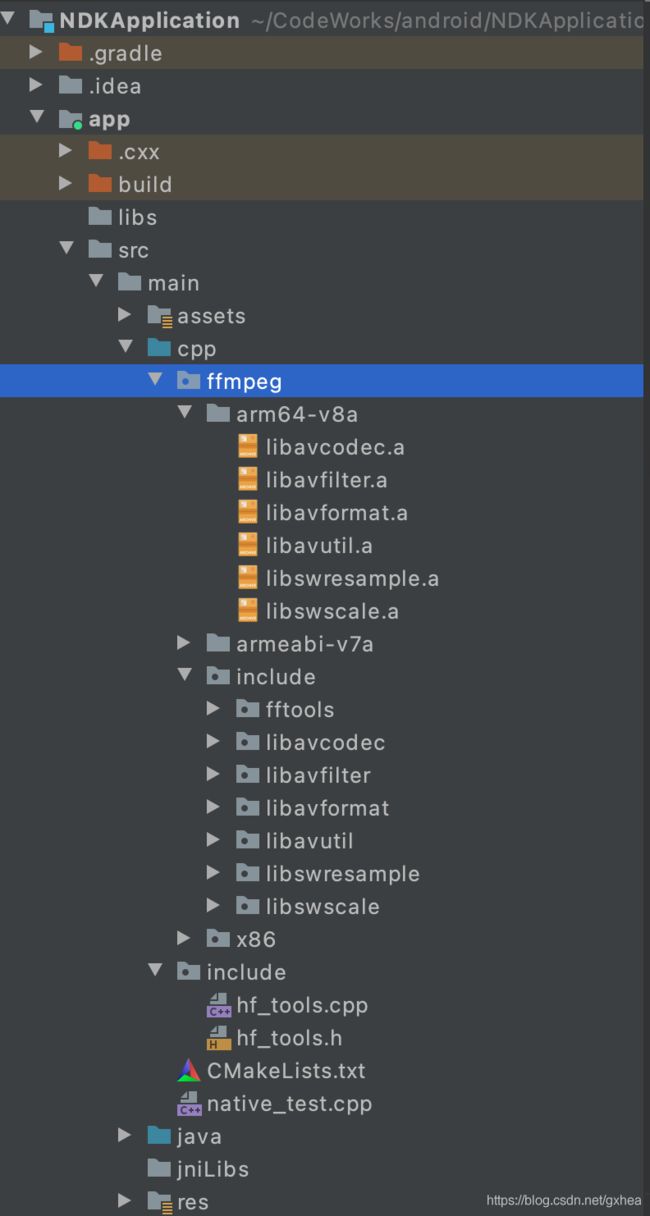Android集成FFmpeg,看这篇就够了
本教程会教大家集成FFmpeg,并使用FFmpeg的代码(非命令行)进行播放mp3。
目录
一、下载FFmpeg源码,编译出静态库.a/动态库.so
二、将库复制到项目中
三、CMakeLists.txt进行第三方库链接
四、gradle.build配置ndk
五、创建Java代码,JNI接口
六、创建cpp,编辑器会自动生成JNI方法
七、执行代码调用
一、下载FFmpeg源码,编译出静态库.a/动态库.so
传送门:https://blog.csdn.net/gxhea/article/details/115539124
二、将库复制到项目中
我编译的是.a静态库,复制到项目中;还需要复制FFmpeg的源代码到项目中,源代码在FFmpeg的根目录,具体复制哪些请看项目结构图片
三、CMakeLists.txt进行第三方库链接
# For more information about using CMake with Android Studio, read the
# documentation: https://d.android.com/studio/projects/add-native-code.html
# Sets the minimum version of CMake required to build the native library.
cmake_minimum_required(VERSION 3.10.2)
#打印LOG
#message(STATUS "Cmake build type is: "${CMAKE_BUILD_TYPE})
#message(STATUS "Cmake build android abi is: "${ANDROID_ABI})
find_library(
log-lib # Android内置的log模块, 用于将JNI层的log打到AS控制台
log )
file(GLOB native_srcs
"*.cpp"
"include/*.cpp"
)
#该指令的主要作用就是将指定的源文件生成链接文件,然后添加到工程中去
add_library( # Sets the name of the library.
my_code
SHARED
${native_srcs}
)
include_directories(src/main/cpp/ffmpeg/include)
target_link_libraries(
my_code
-Wl,--start-group #忽略静态库的链接顺序。
${CMAKE_CURRENT_SOURCE_DIR}/ffmpeg/${ANDROID_ABI}/libavfilter.a
${CMAKE_CURRENT_SOURCE_DIR}/ffmpeg/${ANDROID_ABI}/libavformat.a
${CMAKE_CURRENT_SOURCE_DIR}/ffmpeg/${ANDROID_ABI}/libavcodec.a
${CMAKE_CURRENT_SOURCE_DIR}/ffmpeg/${ANDROID_ABI}/libavutil.a
#${CMAKE_CURRENT_SOURCE_DIR}/ffmpeg/${ANDROID_ABI}/libavdevice.a
${CMAKE_CURRENT_SOURCE_DIR}/ffmpeg/${ANDROID_ABI}/libswresample.a
${CMAKE_CURRENT_SOURCE_DIR}/ffmpeg/${ANDROID_ABI}/libswscale.a
-Wl,--end-group
# -Wl,--start-group #忽略静态库的链接顺序。
# ${CMAKE_CURRENT_SOURCE_DIR}/ffmpeg/arm64-v8a/libavfilter.a
# ${CMAKE_CURRENT_SOURCE_DIR}/ffmpeg/arm64-v8a/libavformat.a
# ${CMAKE_CURRENT_SOURCE_DIR}/ffmpeg/arm64-v8a/libavcodec.a
# ${CMAKE_CURRENT_SOURCE_DIR}/ffmpeg/arm64-v8a/libavutil.a
# #${CMAKE_CURRENT_SOURCE_DIR}/ffmpeg/arm64-v8a/libavdevice.a
# ${CMAKE_CURRENT_SOURCE_DIR}/ffmpeg/arm64-v8a/libswresample.a
# ${CMAKE_CURRENT_SOURCE_DIR}/ffmpeg/arm64-v8a/libswscale.a
# -Wl,--end-group
# -Wl,--start-group #忽略静态库的链接顺序。
# ${CMAKE_CURRENT_SOURCE_DIR}/ffmpeg/armeabi-v7a/libavfilter.a
# ${CMAKE_CURRENT_SOURCE_DIR}/ffmpeg/armeabi-v7a/libavformat.a
# ${CMAKE_CURRENT_SOURCE_DIR}/ffmpeg/armeabi-v7a/libavcodec.a
# ${CMAKE_CURRENT_SOURCE_DIR}/ffmpeg/armeabi-v7a/libavutil.a
# #${CMAKE_CURRENT_SOURCE_DIR}/ffmpeg/armeabi-v7a/libavdevice.a
# ${CMAKE_CURRENT_SOURCE_DIR}/ffmpeg/armeabi-v7a/libswresample.a
# ${CMAKE_CURRENT_SOURCE_DIR}/ffmpeg/armeabi-v7a/libswscale.a
# -Wl,--end-group
# -Wl,--start-group #忽略静态库的链接顺序。
# ${CMAKE_CURRENT_SOURCE_DIR}/ffmpeg/x86/libavfilter.a
# ${CMAKE_CURRENT_SOURCE_DIR}/ffmpeg/x86/libavformat.a
# ${CMAKE_CURRENT_SOURCE_DIR}/ffmpeg/x86/libavcodec.a
# ${CMAKE_CURRENT_SOURCE_DIR}/ffmpeg/x86/libavutil.a
# #${CMAKE_CURRENT_SOURCE_DIR}/ffmpeg/x86/libavdevice.a
# ${CMAKE_CURRENT_SOURCE_DIR}/ffmpeg/x86/libswresample.a
# ${CMAKE_CURRENT_SOURCE_DIR}/ffmpeg/x86/libswscale.a
# -Wl,--end-group
${log-lib}
z #z库 ffmpeg用到
)四、gradle.build配置ndk
plugins {
id 'com.android.application'
id 'kotlin-android'
}
android {
compileSdkVersion 30
buildToolsVersion "30.0.3"
defaultConfig {
applicationId "com.example.ndk"
minSdkVersion 21
targetSdkVersion 30
versionCode 1
versionName "1.0"
ndk {
// 设置支持的SO库架构
abiFilters "armeabi-v7a"
}
externalNativeBuild {
cmake {
cFlags ""
}
}
}
buildTypes {
release {
minifyEnabled false
proguardFiles getDefaultProguardFile('proguard-android-optimize.txt'), 'proguard-rules.pro'
}
}
compileOptions {
sourceCompatibility JavaVersion.VERSION_1_8
targetCompatibility JavaVersion.VERSION_1_8
}
kotlinOptions {
jvmTarget = '1.8'
}
externalNativeBuild {
cmake {
path "src/main/cpp/CMakeLists.txt"
version "3.10.2"
}
}
ndkVersion '21.1.6352462'//as 4+ 新版在这里配ndk
packagingOptions {
exclude 'META-INF/proguard/coroutines.pro'
}
}
dependencies {
implementation "org.jetbrains.kotlin:kotlin-stdlib:$kotlin_version"
implementation 'androidx.core:core-ktx:1.2.0'
implementation 'androidx.appcompat:appcompat:1.1.0'
implementation 'com.google.android.material:material:1.1.0'
implementation 'androidx.constraintlayout:constraintlayout:1.1.3'
}五、创建Java代码,JNI接口
NativeTools.java
package com.example.ndk;
public class NativeTools {
static {
System.loadLibrary("my_code");//这里的名字与cmake文件里面的my_code一致
}
public static native String getWords();
public static native String getFfmpegVersion();
public static native void playMp3(MyPlay myPlay);
}
六、创建cpp,编辑器会自动生成JNI方法
native_test.cpp,需要注意的是:引用ffmpeg的代码必须要extern "C"{}包起来
//
// Created by hins on 4/9/21.
//
#include
#include
#include
#include "android/log.h"
#include
#include "include/hf_tools.h"
extern "C" {
#include "ffmpeg/include/libavcodec/avcodec.h"
#include "ffmpeg/include/libavformat/avformat.h"
#include "ffmpeg/include/libavfilter/avfilter.h"
#include "ffmpeg/include/libavutil/file.h"
#include "ffmpeg/include/libavutil/mathematics.h"
#include "ffmpeg/include/libavutil/time.h"
#include "ffmpeg/include/libavutil/mem.h"
#include "ffmpeg/include/libswresample/swresample.h"
//extern "C"
JNIEXPORT jstring JNICALL
Java_com_example_ndk_NativeTools_getWords(JNIEnv *env, jclass clazz) {
std::string hello = "Hello from C++";
return env->NewStringUTF(hello.c_str());
}
JNIEXPORT jstring JNICALL
Java_com_example_ndk_NativeTools_getFfmpegVersion(JNIEnv *env, jclass clazz) {
char strBuffer[1024 * 4] = {0};
strcat(strBuffer, "libavcodec : ");
strcat(strBuffer, AV_STRINGIFY(LIBAVCODEC_VERSION));
strcat(strBuffer, "\nlibavformat : ");
strcat(strBuffer, AV_STRINGIFY(LIBAVFORMAT_VERSION));
strcat(strBuffer, "\nlibavutil : ");
strcat(strBuffer, AV_STRINGIFY(LIBAVUTIL_VERSION));
strcat(strBuffer, "\nlibavfilter : ");
strcat(strBuffer, AV_STRINGIFY(LIBAVFILTER_VERSION));
strcat(strBuffer, "\nlibswresample : ");
strcat(strBuffer, AV_STRINGIFY(LIBSWRESAMPLE_VERSION));
strcat(strBuffer, "\nlibswscale : ");
strcat(strBuffer, AV_STRINGIFY(LIBSWSCALE_VERSION));
strcat(strBuffer, "\navcodec_configure : \n");
strcat(strBuffer, avcodec_configuration());
strcat(strBuffer, "\navcodec_license : ");
strcat(strBuffer, avcodec_license());
return env->NewStringUTF(strBuffer);
}
JNIEXPORT void JNICALL
Java_com_example_ndk_NativeTools_playMp3(JNIEnv *env, jclass clazz, jobject my_play) {
//1.注册组件,打开音频文件并获取内容,找到音频流
av_register_all();
avformat_network_init();
AVFormatContext *avFormatContext = avformat_alloc_context();//获取上下文
const char *url = "/data/user/0/com.example.ndk/app_mp3/aaa.mp3";
HTools::logd("url is " + string(url));
int ret = avformat_open_input(&avFormatContext, url, NULL, NULL);
if (ret != 0) {
HTools::logd("Couldn't open input stream. " + string(av_err2str(ret)));
return;
} else {
HTools::logd("open input stream. file: " + string(url));
}
//获取码流信息
avformat_find_stream_info(avFormatContext, NULL);
int audio_stream_idx = -1;
for (int i = 0; i < avFormatContext->nb_streams; ++i) {
if (avFormatContext->streams[i]->codec->codec_type == AVMEDIA_TYPE_AUDIO) {
//如果是视频流,标记一哈
audio_stream_idx = i;
HTools::logd("找到了音频流");
}
}
//2.获取解码器,申请avframe和avpacket:
//获取解码器上下文
AVCodecContext *pCodecCtx = avFormatContext->streams[audio_stream_idx]->codec;
//获取解码器
AVCodec *pCodex = avcodec_find_decoder(pCodecCtx->codec_id);
//打开解码器
if (avcodec_open2(pCodecCtx, pCodex, NULL) < 0) {
}
//申请avpakcet,装解码前的数据
AVPacket *packet = (AVPacket *) av_malloc(sizeof(AVPacket));
//申请avframe,装解码后的数据
AVFrame *frame = av_frame_alloc();
HTools::logd("2.获取解码器成功");
//3.初始化SwrContext,进行重采样
//得到SwrContext ,进行重采样,具体参考http://blog.csdn.net/jammg/article/details/52688506
SwrContext *swrContext = swr_alloc();
//缓存区
uint8_t *out_buffer = (uint8_t *) av_malloc(44100 * 2);
//输出的声道布局(立体声)
uint64_t out_ch_layout = AV_CH_LAYOUT_STEREO;
//输出采样位数 16位
enum AVSampleFormat out_formart = AV_SAMPLE_FMT_S16;
//输出的采样率必须与输入相同
int out_sample_rate = pCodecCtx->sample_rate;
//swr_alloc_set_opts将PCM源文件的采样格式转换为自己希望的采样格式
swr_alloc_set_opts(swrContext, out_ch_layout, out_formart, out_sample_rate,
pCodecCtx->channel_layout, pCodecCtx->sample_fmt, pCodecCtx->sample_rate, 0,
NULL);
swr_init(swrContext);
HTools::logd("3.初始化SwrContext,进行重采样成功");
//4.通过while循环读取内容,并通过AudioTrack进行播放:
// 获取通道数 2 ,有单声道,双声道
int out_channel_nb = av_get_channel_layout_nb_channels(AV_CH_LAYOUT_STEREO);
// 反射得到Class类型
jclass david_player = env->GetObjectClass(my_play);
// 反射得到createAudio方法
jmethodID createAudio = env->GetMethodID(david_player, "createTrack", "(II)V");
// 反射调用createAudio
//设置采样率为44100,目前为常用的采样率
env->CallVoidMethod(my_play, createAudio, 44100, out_channel_nb);
jmethodID audio_write = env->GetMethodID(david_player, "playTrack", "([BI)V");
HTools::logd("调用android AudioTrack 开始播放mp3...");
int got_frame;
while (av_read_frame(avFormatContext, packet) >= 0) {
if (packet->stream_index == audio_stream_idx) {
// 解码 mp3 编码格式frame----pcm frame
avcodec_decode_audio4(pCodecCtx, frame, &got_frame, packet);
if (got_frame) {
HTools::logd("解码,读stream");
swr_convert(swrContext, &out_buffer, 44100 * 2, (const uint8_t **) frame->data,
frame->nb_samples);
// 缓冲区的大小
int size = av_samples_get_buffer_size(NULL, out_channel_nb, frame->nb_samples,
AV_SAMPLE_FMT_S16, 1);
jbyteArray audio_sample_array = env->NewByteArray(size);
env->SetByteArrayRegion(audio_sample_array, 0, size, (const jbyte *) out_buffer);
env->CallVoidMethod(my_play, audio_write, audio_sample_array, size);
env->DeleteLocalRef(audio_sample_array);
}
}
}
HTools::logd("5.释放需要释放的资源");
//5.释放需要释放的资源
av_frame_free(&frame);
swr_free(&swrContext);
avcodec_close(pCodecCtx);
avformat_close_input(&avFormatContext);
return;
}
} 七、执行代码调用
整体调用流程是:Java(playMp3) -> JNI -> ffmpeg -> Java(AudioTrack)播放
创建一个于ffmpeg交互的播放器类:MyPlay.java
package com.example.ndk;
import android.media.AudioFormat;
import android.media.AudioManager;
import android.media.AudioTrack;
public class MyPlay {
private AudioTrack audioTrack;
// 这个方法 是C进行调用
public void createTrack(int sampleRateInHz, int nb_channals) {
int channelConfig;//通道数
if (nb_channals == 1) {
channelConfig = AudioFormat.CHANNEL_OUT_MONO;
} else if (nb_channals == 2) {
channelConfig = AudioFormat.CHANNEL_OUT_STEREO;
} else {
channelConfig = AudioFormat.CHANNEL_OUT_MONO;
}
int buffersize = AudioTrack.getMinBufferSize(sampleRateInHz,
channelConfig, AudioFormat.ENCODING_PCM_16BIT);
audioTrack = new AudioTrack(AudioManager.STREAM_MUSIC, sampleRateInHz, channelConfig,
AudioFormat.ENCODING_PCM_16BIT, buffersize, AudioTrack.MODE_STREAM);
audioTrack.play();
}
//C传入音频数据
public void playTrack(byte[] buffer, int lenth) {
if (audioTrack != null && audioTrack.getPlayState() == AudioTrack.PLAYSTATE_PLAYING) {
audioTrack.write(buffer, 0, lenth);
}
}
}
在MainActivity里调用
package com.example.ndk
import android.Manifest
import android.os.Bundle
import android.util.Log
import androidx.appcompat.app.AppCompatActivity
import androidx.core.app.ActivityCompat
import java.io.File
class MainActivity : AppCompatActivity() {
// 要申请的权限
private val permissions = arrayOf(
Manifest.permission.WRITE_EXTERNAL_STORAGE, Manifest.permission.READ_EXTERNAL_STORAGE,
Manifest.permission.CAMERA
)
override fun onCreate(savedInstanceState: Bundle?) {
super.onCreate(savedInstanceState)
setContentView(R.layout.activity_main)
Log.d(ConsData.TAG, "native :" + NativeTools.getWords())
///data/user/0/com.example.ndk
val dir: File = getDir(ConsData.DIR_MP3, MODE_PRIVATE)
val p = dir.absolutePath
val fileMp3 = File("$p/aaa.mp3")
if(!fileMp3.exists()) {
FileUtils.copyAssetsFiles2Dir(this, "aaa.mp3")
}
var myPlay = MyPlay()
var t = Thread(object : Runnable {
override fun run() {
Log.d(ConsData.TAG, "ffmpeg do run...")
NativeTools.playMp3(myPlay)
}
});
t.start()
ActivityCompat.requestPermissions(this, permissions, 321);
}
} 最后你会,听 海哭的声音

